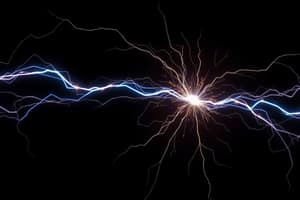Podcast
Questions and Answers
What is the modern view on electric charges?
What is the modern view on electric charges?
- They are only positive in nature
- They are only negative in nature
- They are composed of protons
- They correspond to the presence of surplus or deficit of electrons (correct)
What do like charges do when they come near each other?
What do like charges do when they come near each other?
- Annihilate
- Combine
- Repel (correct)
- Attract
Which scientist's work led to the modern classification of charges as 'positive' and 'negative'?
Which scientist's work led to the modern classification of charges as 'positive' and 'negative'?
- Johannes Kepler
- Albert Einstein
- Benjamin Franklin (correct)
- Isaac Newton
What happens in an electric field around a charged particle?
What happens in an electric field around a charged particle?
How is the electric field defined?
How is the electric field defined?
What is the relationship between electric field strength and distance from the source of the electric field?
What is the relationship between electric field strength and distance from the source of the electric field?
What is responsible for giving objects electric charge?
What is responsible for giving objects electric charge?
What is the charge of electrons that leads to negative charges?
What is the charge of electrons that leads to negative charges?
'Positive' and 'negative' charges correspond to a presence of surplus or deficit of what particles?
'Positive' and 'negative' charges correspond to a presence of surplus or deficit of what particles?
Flashcards are hidden until you start studying
Study Notes
Introduction
Electrostatics is a branch of physics concerned with the properties and behavior of electric charges at rest. This subtopic forms the foundation for understanding the principles behind electron flow, chemical reactions, and many electronic devices.
Charge
Objects acquire electric charge through processes like rubbing or physical contact. Early observations showed that like charges repel each other, while unlike charges (positive and negative) attract. The modern view of charge dividing into two types, 'positive' and 'negative', traces back to the work of Benjamin Franklin. It is now known that these charges correspond to the presence of surplus or deficit of electrons, which are negatively charged particles found in atoms.
Electric Field
An electric field is a vector quantity that represents the region around a charged particle or system of particles where other charged bodies experience a force due to the presence of the first body. The electric field is defined as the force exerted on a unit positive test charge placed at any point in space. It can be calculated using Coulomb's Law or other formulations.
The electric field has both magnitude and direction, and it is independent of the test charge size. Its strength decreases with distance from the source of the electric field. Electric fields are instrumental in describing interactions between charged bodies in various contexts like static electricity, electromagnetic waves, and even molecular biology where large molecules such as proteins and DNA interact through electrostatic forces.
Studying That Suits You
Use AI to generate personalized quizzes and flashcards to suit your learning preferences.




